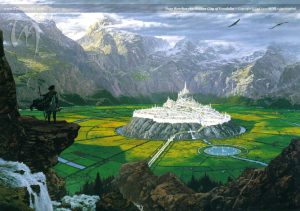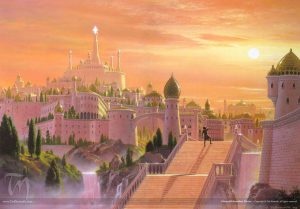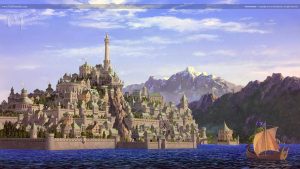
The Two Trees of Valinor, as depicted on Amazon Studios' Rings of Power
Once upon a time, J. R. R. Tolkien simply wanted to write stories. Over time, these stories seemed to fit in their own world, the kind of fantasy one told of the elder days when the world was young and the fantastic wasn't quite so grounded.
Long before The Hobbit or The Lord of the Rings, Tolkien began writing original fairy tales, inspired in part by ancient history and epic poems, but with no firm connection to actual history. In 1914, while serving in World War I, Tolkien began his musings. He later wrote his first story, The Fall of Gondolin in 1917. In 1920, Tolkien read for one of his classes. This was the origin of Middle Earth, before Middle Earth was even really a concept! This early version based in-part on his war experiences went unpublished throughout his life. Christopher Tolkien, in 1977, edited the story for inclusion into a posthumous work, and the original tale remained unpublished until being included in another book: The Book of Lost Tales.
This is all a bit meandering, but it reaches to the heart of the problem. As the early 20th century progressed, Tolkien began writing The Hobbit by 1930, but he did not work solely on it. Over the years, Tolkien published more stories and even published a fictional language for the elves of his stories. While the Hobbit was originally published in 1933 as its own story, it was not until after that Tolkien realized his story fit into the broader history he had slowly been piecing together since 1917.
After the success of The Hobbit, Tolkien's publisher predictably asked for a sequel. Already equipped with numerous pages of notes and stories, Tolkien submitted his collection.... only to be rejected! Yes, J.R.R. Tolkien, the Father of Modern Fantasy, was rejected by his publisher! Hard to imagine, right?
In fairness, perhaps no one (not even Tolkien) was ready to publish the Silmarillion. Tolkien's collection of notes were just that: a collection. These notes did not have any central character or story thread. The publisher argued it was archaic and 'too Celtic'. And thus, Tolkien was encouraged to write a sequel to The Hobbit that would actually follow the events of his successfully published work. This, of course, was The Lord of the Rings.

While Tolkien worked on writing The Lord of the Rings from 1937 to 1955, he never quite abandoned his work on his other stories. It was clear to him by this point that all of his stories fit into a single, unified timeline of a single place over many years; This was the creation of Middle Earth, and in Tolkien's mind, also an alternative mythos for our own ancient history. Middle Earth of course derived from the ancient Norse tradition, where Earth is called Midgard. Tolkien was a great historian and professor of Anglo Saxon, and completed much study on the histories and epic sagas. At this time, Tolkien was also the first author to prominently support the study of Beowulf on literary merits.
As he developed the backstory of his novels, Tolkien's development focused more and more on the Ring. Originally just a magic ring discovered by The Hobbit's titular protagonist, the now iconic artifact was a weapon of great power and evil. The mysterious Necromancer, also from The Hobbit, was elaborated on into the Dark Lord Sauron. Sauron, along with Gandalf, were clarified as beings of a higher order, originating from a time far in Middle Earth's history. They were not unique either, but instead one of many, as Tolkien developed the concept of the Ainur. The Ainur, split between maiar and valar, were heavenly creatures who took man-like shape and wielded great power over the natural elements. Tolkien's Ainur were based in part on the Norse gods, with influence from Greek myths and Christian theology as well. Above this all, Tolkien revealed the existence of Eru Iluvatar, the creation deity, whom created and guided all. Tolkien was a devout Catholic, along with friend and peer C. S. Lewis, and his learning and belief heavily influenced his work. In any case, Tolkien was making clear references between Middle Earth, Midgard, and the Earth we are familiar with.

After publishing The Return of the King in 1955, Tolkien spent the remainder of his days writing more stories. By this time, most of the actual stories were already written, and he spent most of his time on the various theological questions of his work, such as the Ainur, the creation of Middle Earth, and where orcs came from. Tolkien made little progress overall before he died in 1973 at the age of 81.
Christopher Tolkien, his youngest son, continued the work as J.R.R. Tolkien's literary executor. Christopher was an early collaborator, having heard many of the stories orally from his father, offering input on their development and even helping draw the original maps in The Lord of the Rings. Thus, it fell to Christopher to finish the work to the best of his ability. Teaming up with fantasy author Guy Gavriel Kay, the two dove through Tolkien's notes and pieced together a narrative, which was finally visible after more than forty years of writing. Four years later, they published the collected works as The Silmarillion.
The Silmarillion published as a history book in five parts, telling the back story leading up to The Hobbit and The Lord of the Rings. The publication was in-universe collected and translated by Bilbo Baggins, and it included the books he bequethed to Frodo, in much the same way the elder Tolkien passed his on to Christopher. The overall collection is the first example of a 'lore book' for a fictional series, serving as the foundational core for the rest of the series.
The book begins with the creation of Middle Earth by the Ainur. Eru Iluvatar comes out of the void and is joined by the Ainur. Together, they sing the world of Arda into existence, but not without the discord brought by Melkor. The story follows with the decay of Melkor and his corruption of some of his fellow Ainur, leading to the first rebellion and war between their kind, and it caused the destruction of the two great Lamps that lit the world.
Many years later, the elves awaken and Melkor is imprisoned. The Ainur who chose to come down to Arda shepard the elves westward to join them in Valinor, a new land where the light of the Lamps has been replaced by two great trees. Many years later, Melkor feigns rehabilitation and is released. He covets the three Silmaril jewels made by Feanor, son of the elven High King. Melkor teams with the great spider Ungoliant to destroy the trees, murder the king, and steal the jewels. Feanor forsakes the ainur and leads most of his people back to the world they left behind, Middle Earth, to wage war on Melkor for the silmarils.
In a series of stories and wars that parallel The Lord of the Rings, the elves meet with humans and dwarves and band together to defeat Melkor (now renamed Morgoth) and his minions. Morgoth is too strong and cannot be defeated without the aid of the rest of the Ainur. They manage to capture Morgoth for good, but they don't capture his servant Sauron. Sauron flees, only to return and attempt to enslave the free races of Middle Earth. However, he was cast down when the source of his power, his evil Ring, is taken from him.

The Silmarillion was the culmination of Tolkien's work. While other stories were individually published later on, like The Children of Hurin and The Fall of Gondolin, The Silmarillion was the last original work to be published. The book was later redivided and republished in a 12-volume set called The History of Middle Earth between 1983 and 1996.
And thus, our celebration of Hobbit Day comes to an end. But as in all things, Gandalf had this to say:
"End? No, the journey doesn't end here."
Until next time!


Add a comment to: Hobbit Day 2023: The Silmarillion